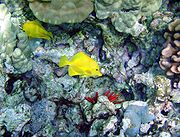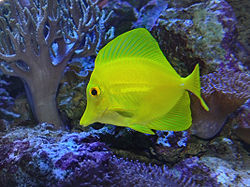
Yellow tang
Encyclopedia
The yellow tang is a saltwater fish
species
of the family
Acanthuridae
. It is one of the most popular aquarium
fish.
They have an arrow-like shape due to their dorsal
and ventral fins being almost an extension to their bodies, and a long snout-like mouth used (as with other tangs) to eat algae
. They also have a sharp spine located near their tail. They have become a popular fish for marine aquarists
of all skill levels, as the fish tends to be active, hardy, and nonaggressive when kept with dissimilar species.
to marine turtles, by removing algal growth from their shells.
 It is commonly found in shallow reef
It is commonly found in shallow reef
s, from 2–46 m (6.6–150.9 ft) deep, in the Pacific
and Indian
Oceans, west of Hawaii
and east of Japan
.
Hawaii is the most common place for aquarium harvesting, where up to 70% of the yellow tangs for the aquarium industry are sourced from.
 The yellow tang is a very commonly kept as a saltwater aquarium fish. They can grow up to 8 inches (20.3 cm), although 6 inches (15.2 cm) is more common in the wild. They require an aquarium
The yellow tang is a very commonly kept as a saltwater aquarium fish. They can grow up to 8 inches (20.3 cm), although 6 inches (15.2 cm) is more common in the wild. They require an aquarium
of at least 75 gallons, while 100+ gallons is preferred. They are usually very hardy, although, like all Tangs, are quite susceptible to Cryptocaryon Irritans (a parasite resembling Freshwater "Ich") and other common saltwater diseases. They are semi-aggressive. They normally successfully cohabit with other semi-aggressive fish close to their own size. Tangs can thrive with others in pairs or in a group in large tanks (150+ gallons). Possible other tankmates include fish such as cardinalfish, large clownfish
, lionfish
, eel
s, or other Tangs such as the blue tang
or Achilles tang. They are reef-safe, and can be kept with any invertebrates in a reef aquarium
.
Fish
Fish are a paraphyletic group of organisms that consist of all gill-bearing aquatic vertebrate animals that lack limbs with digits. Included in this definition are the living hagfish, lampreys, and cartilaginous and bony fish, as well as various extinct related groups...
species
Species
In biology, a species is one of the basic units of biological classification and a taxonomic rank. A species is often defined as a group of organisms capable of interbreeding and producing fertile offspring. While in many cases this definition is adequate, more precise or differing measures are...
of the family
Family (biology)
In biological classification, family is* a taxonomic rank. Other well-known ranks are life, domain, kingdom, phylum, class, order, genus, and species, with family fitting between order and genus. As for the other well-known ranks, there is the option of an immediately lower rank, indicated by the...
Acanthuridae
Acanthuridae
Acanthuridae is the family of surgeonfishes, tangs, and unicornfishes. The family includes about 80 species in six genera, all of which are marine fish living in tropical seas, usually around coral reefs...
. It is one of the most popular aquarium
Aquarium
An aquarium is a vivarium consisting of at least one transparent side in which water-dwelling plants or animals are kept. Fishkeepers use aquaria to keep fish, invertebrates, amphibians, marine mammals, turtles, and aquatic plants...
fish.
Appearance
Yellow tang are in the surgeonfish family. Adult fish can grow to 20 centimetres (7.9 in) in length, and 1–2 cm (0.393700787401575–0.78740157480315 in) in thickness. Adult males tend to be larger than females. All individuals of this species are bright daffodil yellow in color. At night, the yellow coloring fades slightly and a prominent brownish patch develops in the middle with a horizontal white band. They rapidly resume their bright yellow color with daylight.They have an arrow-like shape due to their dorsal
Dorsum (biology)
In anatomy, the dorsum is the upper side of animals that typically run, fly, or swim in a horizontal position, and the back side of animals that walk upright. In vertebrates the dorsum contains the backbone. The term dorsal refers to anatomical structures that are either situated toward or grow...
and ventral fins being almost an extension to their bodies, and a long snout-like mouth used (as with other tangs) to eat algae
Algae
Algae are a large and diverse group of simple, typically autotrophic organisms, ranging from unicellular to multicellular forms, such as the giant kelps that grow to 65 meters in length. They are photosynthetic like plants, and "simple" because their tissues are not organized into the many...
. They also have a sharp spine located near their tail. They have become a popular fish for marine aquarists
Aquarium
An aquarium is a vivarium consisting of at least one transparent side in which water-dwelling plants or animals are kept. Fishkeepers use aquaria to keep fish, invertebrates, amphibians, marine mammals, turtles, and aquatic plants...
of all skill levels, as the fish tends to be active, hardy, and nonaggressive when kept with dissimilar species.
Food
In the wild, yellow tang feed on benthic turf algae and other marine plant material. In captivity they are commonly fed meat/fish based aquarium food, but the long term health effects of this diet are questionable. In the wild, yellow tang provide cleaner servicesCleaning station
A cleaning station is a location where fish, sea turtles, hippo and other aquatic life, freshwater and marine, congregate to be cleaned.The cleaning process includes the removal of parasites from the animal's body , and can be performed by various creatures A cleaning station is a location where...
to marine turtles, by removing algal growth from their shells.
Distribution and habitats

Reef
In nautical terminology, a reef is a rock, sandbar, or other feature lying beneath the surface of the water ....
s, from 2–46 m (6.6–150.9 ft) deep, in the Pacific
Pacific Ocean
The Pacific Ocean is the largest of the Earth's oceanic divisions. It extends from the Arctic in the north to the Southern Ocean in the south, bounded by Asia and Australia in the west, and the Americas in the east.At 165.2 million square kilometres in area, this largest division of the World...
and Indian
Indian Ocean
The Indian Ocean is the third largest of the world's oceanic divisions, covering approximately 20% of the water on the Earth's surface. It is bounded on the north by the Indian Subcontinent and Arabian Peninsula ; on the west by eastern Africa; on the east by Indochina, the Sunda Islands, and...
Oceans, west of Hawaii
Hawaii
Hawaii is the newest of the 50 U.S. states , and is the only U.S. state made up entirely of islands. It is the northernmost island group in Polynesia, occupying most of an archipelago in the central Pacific Ocean, southwest of the continental United States, southeast of Japan, and northeast of...
and east of Japan
Japan
Japan is an island nation in East Asia. Located in the Pacific Ocean, it lies to the east of the Sea of Japan, China, North Korea, South Korea and Russia, stretching from the Sea of Okhotsk in the north to the East China Sea and Taiwan in the south...
.
Hawaii is the most common place for aquarium harvesting, where up to 70% of the yellow tangs for the aquarium industry are sourced from.
In the Aquarium

Aquarium
An aquarium is a vivarium consisting of at least one transparent side in which water-dwelling plants or animals are kept. Fishkeepers use aquaria to keep fish, invertebrates, amphibians, marine mammals, turtles, and aquatic plants...
of at least 75 gallons, while 100+ gallons is preferred. They are usually very hardy, although, like all Tangs, are quite susceptible to Cryptocaryon Irritans (a parasite resembling Freshwater "Ich") and other common saltwater diseases. They are semi-aggressive. They normally successfully cohabit with other semi-aggressive fish close to their own size. Tangs can thrive with others in pairs or in a group in large tanks (150+ gallons). Possible other tankmates include fish such as cardinalfish, large clownfish
Clownfish
Clownfish or anemonefish are fishes from the subfamily Amphiprioninae in the family Pomacentridae. Twenty-eight species are recognized, one in the genus Premnas, while the remaining are in the genus Amphiprion. In the wild they all form symbiotic mutualisms with sea anemones...
, lionfish
Lionfish
Lionfish may refer to:* genus Pterois, collectively known as the lionfish* Red Lionfish , a significant invasive species off the East Coast of North America and in the Caribbean-Fish:...
, eel
Eel
Eels are an order of fish, which consists of four suborders, 20 families, 111 genera and approximately 800 species. Most eels are predators...
s, or other Tangs such as the blue tang
Blue tang
Paracanthurus hepatus is a species of Indo-Pacific surgeonfish. A popular fish in marine aquaria, it is the only member of the genus Paracanthurus...
or Achilles tang. They are reef-safe, and can be kept with any invertebrates in a reef aquarium
Aquarium
An aquarium is a vivarium consisting of at least one transparent side in which water-dwelling plants or animals are kept. Fishkeepers use aquaria to keep fish, invertebrates, amphibians, marine mammals, turtles, and aquatic plants...
.
External links
- Yellow Tang Yellow tang Overview - Everything about the Zebrasoma flavescens (Yellow Tang) fish.
- AquariumDomain Complete Resource for the Marine Aquarium Hobbyist.

